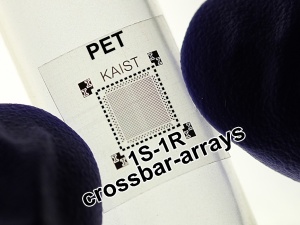Korean scientists are trying to make the process of creating flexible electronics easier according to a Nov. 25, 2014 news item on ScienceDaily,
Flexible electronics have been touted as the next generation in electronics in various areas, ranging from consumer electronics to bio-integrated medical devices. In spite of their merits, insufficient performance of organic materials arising from inherent material properties and processing limitations in scalability have posed big challenges to developing all-in-one flexible electronics systems in which display, processor, memory, and energy devices are integrated. The high temperature processes, essential for high performance electronic devices, have severely restricted the development of flexible electronics because of the fundamental thermal instabilities of polymer materials.
A research team headed by Professor Keon Jae Lee of the Department of Materials Science and Engineering at KAIST provides an easier methodology to realize high performance flexible electronics by using the Inorganic-based Laser Lift-off (ILLO).
The process is described in a Nov. 26, 2014 KAIST news release on ResearchSEA, which originated the news item (despite the confusion of the date, probably due to timezone differentials), provides more detail about the technique for ILLO,
The ILLO process involves depositing a laser-reactive exfoliation layer on rigid substrates, and then fabricating ultrathin inorganic electronic devices, e.g., high density crossbar memristive memory on top of the exfoliation layer. By laser irradiation through the back of the substrate, only the ultrathin inorganic device layers are exfoliated from the substrate as a result of the reaction between laser and exfoliation layer, and then subsequently transferred onto any kind of receiver substrate such as plastic, paper, and even fabric.
This ILLO process can enable not only nanoscale processes for high density flexible devices but also the high temperature process that was previously difficult to achieve on plastic substrates. The transferred device successfully demonstrates fully-functional random access memory operation on flexible substrates even under severe bending.
Professor Lee said, “By selecting an optimized set of inorganic exfoliation layer and substrate, a nanoscale process at a high temperature of over 1000 °C can be utilized for high performance flexible electronics. The ILLO process can be applied to diverse flexible electronics, such as driving circuits for displays and inorganic-based energy devices such as battery, solar cell, and self-powered devices that require high temperature processes.”
Here’s a link to and a citation for the research paper,
Flexible Crossbar-Structured Resistive Memory Arrays on Plastic Substrates via Inorganic-Based Laser Lift-Off by Seungjun Kim, Jung Hwan Son, Seung Hyun Lee, Byoung Kuk You, Kwi-Il Park, Hwan Keon Lee, Myunghwan Byun and Keon Jae Lee. Advanced Materials Volume 26, Issue 44, pages 7480–7487, November 26, 2014 Article first published online: 8 SEP 2014 DOI: 10.1002/adma.201402472
© 2014 WILEY-VCH Verlag GmbH & Co. KGaA, Weinheim
Here’s an image the researchers have made available,
Finally, the research paper is behind a paywall.
